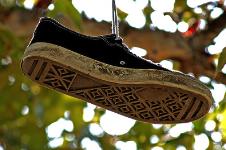Capoeira Shoes

When training a lot in capoeira, using shoes is a great option.
Good capoeira shoes will keep your feet comfortable and pain free while training the diverse range of capoeira movements.
There are a lot of options available for shoes, but for capoeira there are some criteria to keep in mind. Aside from the type of shoes, the first is deciding whether to wear them at all…
Shoes vs. No Shoes
The decision to use shoes or train barefoot comes down to a matter of preference. Each option has its own pros and cons, both of which I’ve experienced. I’ll share some of these so you can be better informed to decide for yourself.
- Blistering and Callusing – Many people make their decision to train with shoes based on foot blistering. When you train intensely and frequently enough without shoes, it’s a pretty sure bet your feet will start blistering. And it can hurt…a lot!
Blistering isn’t necessarily bad though. It’s the first step to getting callused feet. At this point, your feet become hardened and training barefoot becomes a breeze. Keep this in mind when making the choice for shoes or not.
- Different grip – Wearing capoeira shoes changes the grip you have against the floor. This can be both good and bad. They’re useful when performing movements that require more grip, like a lot of escapes. However, I like training barefoot when doing spinning kicks since I’m able to rotate better on my feet.
- Comfort – An obvious factor is comfort. Some people feel more comfortable with shoes just as some feel more without. In this case, try both and judge how you feel afterwards.
With either option, feel free to experiment and remember you aren’t forced into either one or the other. I normally switch between both options based on how I feel and what moves I’m training.
Type of Shoe
When choosing shoes to wear for capoeira, it’s really important to get the right type.
You don’t want your game to be limited by your shoes!
Here are a couple of tips to keep in mind…
- Flat sole – Make sure to get capoeira shoes with flat soles, meaning no treads! Treads have a habit of breaking off due to the quick, foot intensive movements in capoeira. Having a flat sole also helps in balance better than treaded shoes do.
- Right grip – The shoes have to have a good balance between grip and slip. If the shoes grip too much, you won’t be able to pivot or spin your foot, which is essential for many moves. However if they’re too slippery, you won’t have the footing for a lot of movements either.
Pay attention to the floor you train on and keep this in mind when getting shoes.
- Light weight – Another consideration is getting light weight shoes. Wearing shoes can add significant weight which makes a difference while training.
You don’t want to be performing a meia lua de compasso with bricks on your feet!
Make sure to stick to light shoes, the lighter the better.
Where to Buy
Now that you have a good idea of what to look for in a shoe, here are some good choices I’ve used and seen used for capoeira shoes.
- Pumas – Puma’s offer a lot of good quality shoes that are lightweight, have good grip and flat soles. I currently train in a pair of puma speed cats that I’ve had for over 4 years. They still are in great condition and going strong.
- Feiyue - I've always seen at least one person with these shoes anywhere there's capoeira. These shoes are used a lot in Chinese martial arts. They are cheap, lightweight and flat soled; perfect for capoeira.
- Converse – Converse’s low top Chuck Taylors are another good pair of shoes for capoeira. I have a pair I use every time I play outside on hard surfaces like concrete.
Return from Capoeira Shoes to Capoeira Clothes
Return to Start Playing Capoeira


